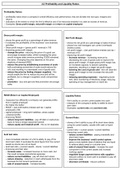-
1. Summary - Ib business & management - revision poster - 5.7 contingency planning and crisis mana...
-
2. Summary - Ib business & management (hl) - revision poster - 5.6 research and development
-
3. Summary - Ib business & management (hl) - revision poster - 5.5 production planning
-
4. Summary - Ib business & management - revision poster - 5.4 location
-
5. Summary - Ib business & management (hl) - revision poster - 5.3.2 quality management
-
6. Summary - Ib business & management - revision poster - 5.3.1 lean production
-
7. Summary - Ib business & management - revision poster - 5.2 production methods
-
8. Summary - Ib business & management - revision poster - 5.1 the role of operations management
-
9. Summary - Ib business & management (hl) - revision poster - 4.8 e-commerce
-
10. Summary - Ib business & management (hl) - revision poster - 4.7 international marketing
-
11. Summary - Ib business & management - revision poster - 4.6 the extended marketing mix
-
12. Summary - Ib business & management - revision poster - 4.5.4 place
-
13. Summary - Ib business & management - revision poster - 4.5.3 promotion
-
14. Summary - Ib business & management (hl) - revision poster - 4.5.2 price
-
15. Summary - Ib business & management - revision poster - 4.5.1 product
-
16. Summary - Ib business & management - revision poster - 4.4.2 market research
-
17. Summary - Ib business & management (hl) - revision poster - 4.4.1 market research
-
18. Summary - Ib business & management (hl) - revision poster - 4.3 sales forecasting
-
19. Summary - Ib business & management (hl) - revision poster - 4.2 marketing planning
-
20. Summary - Ib business & management (hl) - revision poster - 4.1 the role of marketing
-
21. Summary - Ib business & management (hl) - revision poster - 3.9 budgets
-
22. Summary - Ib business & management (hl) - revision poster - 3.8 investment appraisal
-
23. Summary - Ib business & management (hl) - revision poster - 3.7 cash flow
-
24. Summary - Ib business & management (hl) - revision poster - 3.6 efficiency ratios
-
25. Summary - Ib business & management (hl) - revision poster - 3.5 profitability and liquidity rat...
-
26. Summary - Ib business & management (hl) - revision poster - 3.4 final accounts
-
27. Summary - Ib business & management - revision poster - 3.3 break even analysis
-
28. Summary - Ib business & management (hl) - revision poster - 3.2 costs and revenue
-
29. Summary - Ib business & management (hl) - revision poster - 3.1 sources of finance
-
30. Summary - Ib business & management (hl) - revision poster - 2.6.2 employee/employer industrial ...
-
31. Summary - Ib business & management (hl) - revision poster - 2.6.1 employee/employer industrial ...
-
32. Summary - Ib business & management (hl) - revision poster - 2.5 organisational culture
-
33. Summary - Ib business & management (hl) - revision poster - 2.4 motivation
-
34. Summary - Ib business & management (hl) - revision poster - 2.3 leadership and management
-
35. Summary - Ib business & management (hl) - revision poster - 2.2.2 organisational structure
-
36. Summary - Ib business & management (hl) - revision poster - 2.2.1 organisational structure
-
37. Summary - Ib business & management (hl) - revision poster - 2.1.2 training
-
38. Summary - Ib business & management (hl) - revision poster - 2.1.1 workforce planning
-
39. Summary - Ib business & management (hl) - revision poster - 1.7 organisational planning tools
-
40. Summary - Ib business & management (hl) - revision poster - 1.6.2 growth and evolution
-
41. Summary - Ib business & management (hl) - revision poster - 1.6.1 growth and evolution
-
42. Summary - Ib business & management (hl) - revision poster - 1.5 external environment
-
43. Summary - Ib business & management (hl) - revision poster - 1.4 stakeholders
-
44. Summary - Ib business & management (hl) - revision poster - 1.3 organisational objectives
-
45. Summary - Ib business & management (hl) - revision poster - 1.2 types of organisations
-
46. Summary - Ib business & management (hl) - revision poster - 1.1 introduction to business manage...
-
Show more




